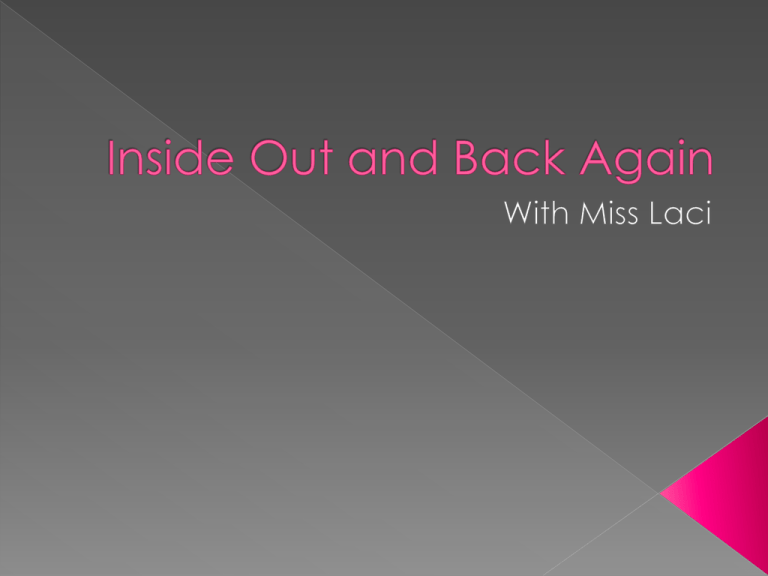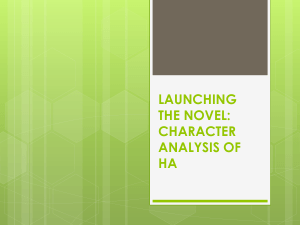Inside Out and Back Again
advertisement

I can support my inferences with evidence from text. I can participate in discussions about the text with a partner, small group, and the whole class. What is home? How do critical incidences reveal character? Look around the room at the pictures posted. With your binder and a pen, walk from picture to picture. At each picture describe what you’re seeing, and write down one question that arises. You will be given two strips of paper. Read them and try to figure out what they could be about. Time to mix and mingle! › Try to find 3 other people with different strips from you. › Between the four of you, put the strips in order and infer what the strips are about. Answer the essential questions to the best of your ability. What is a stanza? Where do you normally see stanzas? What does the word gist mean? Where have you heard it before? What are skills of good close readers? I can make inferences to deepen my understanding of Inside Out & Back Again. I can cite evidence from the novel to explain how incidents reveal aspects of Ha’s character. I can use context clues to figure out word meanings. I can participate in discussions about the text with a partner, small group, and the whole class. Based on what you saw and read yesterday, what do you think might have to happen to a little girl to make her say that she would prefer war at home in Saigon (Vietnam) to peace in Alabama (the United States) I am about to hand out brand new books to you! You now have the responsibility to treat this book the way you want to be treated! Hold up your right hand and repeat after me! I so solemnly swear to treat this book with the kindness and love that I would my own child. I will not return it with rips and tears. I will use a book mark and not fold the pages. I will never put a mark of any kind on the pages. I will do my best to return the book in the condition in which it was given to me in. I promise to hand my book back in on time. Briefly flip through the book. › What do you notice about how this novel is written? › How is it like other novels you have read? › How is it different? Each entry is written in short, free verse poetry. Free verse poetry is poetry that doesn’t use a regular rhythm or rhyming pattern. It does, however, look like a poem with the layout and line breaks. While someone is reading out loud, be sure to follow along in your head. While we are reading, think about the gist of each poem. Have post-it notes and a pen handy! What details really strike you about this poem? Why? In your notebook respond to: › “What have you learned about Ha in this very first poem?” › Record the line numbers that help you to characterize her. › Write how you characterized her (actions, thoughts, dialogue). “Tet is a special day. When is Tet, and what two events are celebrated on Tet?” “How does the family celebrate Tet?” “So, how does this special day affect the other days?” “What does the narrator (Ha) do that might bring bad luck?” “What can you infer about the narrator based on this action? In other words, what can you figure out about her, based on what you see in the text, and what you already know?” What can you infer about the narrator based on this action? In other words, what can you figure out about her, based on what you see in the text, and what you already know? Turn and talk to a partner about what last night’s reading was about. Was your idea of the gist the same as your partner’s? Did you remember something else as you shared and listened?” “How do the events in this poem connect to the first poem we read, ‘1975: Year of the Cat,’ and the title of the novel, Inside Out & Back Again?” “What specifically does the fortune-teller predict about the family’s future?” “Ha lives in a war-torn country. How does she hope her life will be turned inside out?” “Ha knows that ‘inside out’ probably means something different. What will probably happen?” Based on what you have read so far in the novel, what can you infer about what will happen to Ha and her family? Be sure to use details from the text to support your answer. Hold Up A Color Reread pages 4–9 of Inside Out & Back Again (from “Inside Out” through “Papaya Tree”). QuickWrite 1:What kind of person is Ha? Use specific evidence from the text to write a paragraph in which you discuss one of Ha’s personality traits. A complete paragraph will include a focus statement, several pieces of textual evidence, explanations about what each piece of evidence shows us about Ha, and a concluding sentence. Use the notes you collected in your journal to help you write this paragraph. What is descriptive language? How does a writer incorporate descriptive language into his/her work? What types of parts of speech show description? Reread the Papaya Tree on pages 8-9 What new or important details struck you after hearing the poem read aloud again? Diction: Word Choice Connotation: Word Association Denotation: Dictionary Definition Why might the author have chosen this particular tree to focus on? How did the papaya tree begin to grow? Was the planting of the tree intentional or a careless act? How do you know this?” From youngest to oldest, Ha describes what each brother sees on the tree. What is the pattern she describes? Ha vows to be the first to witness, or observe, the ripening of the papaya fruit. What does the word vows mean in this context? Where else did we read that Ha wanted to be the first at something instead of her oldest brother? What can you infer or conclude about Ha’s character based on these two poems or critical incidents? Read pages 10–21, from “TiTi Waves Goodbye” through “Two More Papayas,” and complete QuickWrite 2. How is Ha’s life affected by where and when she is living? Write a complete paragraph in which you support your ideas with evidence from the text.






